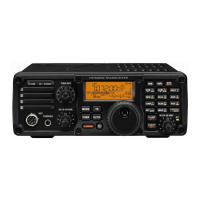q PASSBAND TUNING CONTROLS [TWIN PBT]
Adjust the receiver’s DSP filter passband width.
(p. 46)
• The limit of the variable range depends on the pass-
band width and mode. The limit of the variable range
is half of the passband width, and PBT is adjustable in
200 Hz (AM) or 50 Hz (other models) steps.
• Rotate both [TWIN PBT] controls (PBT1 and PBT2) to
the same position shifts the IF.
4 What is the PBT control?
Generally, the PBT electronically narrows the IF
passband width to reject interference. This trans-
ceiver uses the DSP circuit for the PBT function.
w NOISE BLANKER KEY
NB
(p. 49)
➥ Push to turn the noise blanker function ON or
OFF.
• “ ” appears on the display.
➥ Push and hold for 1 sec to enter the noise
blanker set mode for setting the noise blanker
level and blank time
; push again to return to nor-
mal operation.
• When entering the noise blanker set mode, the noise
blanker function is automatically turned ON.
4 What is the noise blanker?
The noise blanker reduces pulse-type noise such
as that generated by automobile ignition systems.
This function is not effective against non pulse-type
noise.
e NR KEY
NR
(p. 50)
➥ Push to turn the noise reduction function ON or
OFF.
• “ ” appears on the display.
➥ Push and hold for 1 sec. to enter the noise re-
duction level set mode
; push again to return to
normal operation.
• When entering the noise reduction set mode, the
noise reduction function is automatically turned ON.
4 What is the Noise Reduction function?
The Noise Reduction (NR) function removes ran-
dom noise from the receiver passband. The level is
adjustable to allow maximum clarity without harm-
ing the intelligibility of the desired signal. Noise Re-
duction should generally not be used with digital
modes.
1
1
PANEL DESCRIPTION

